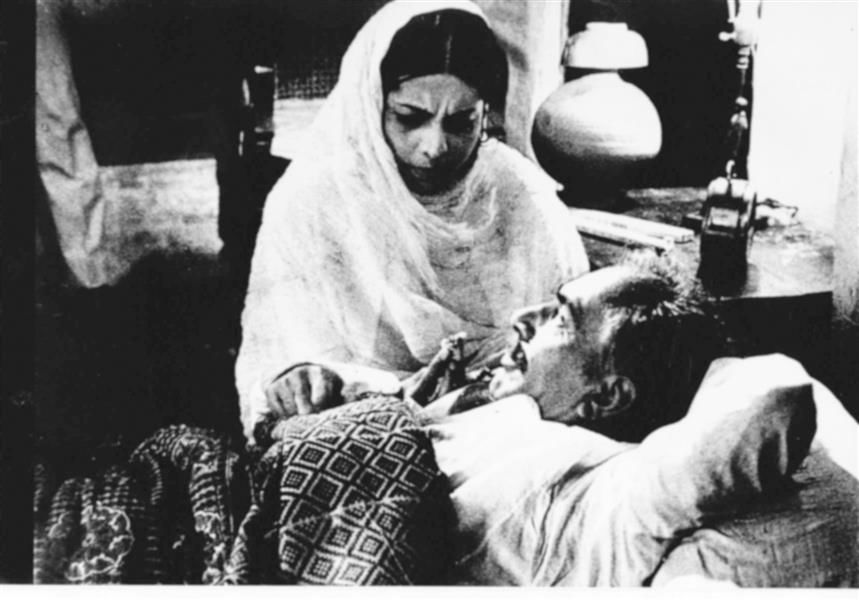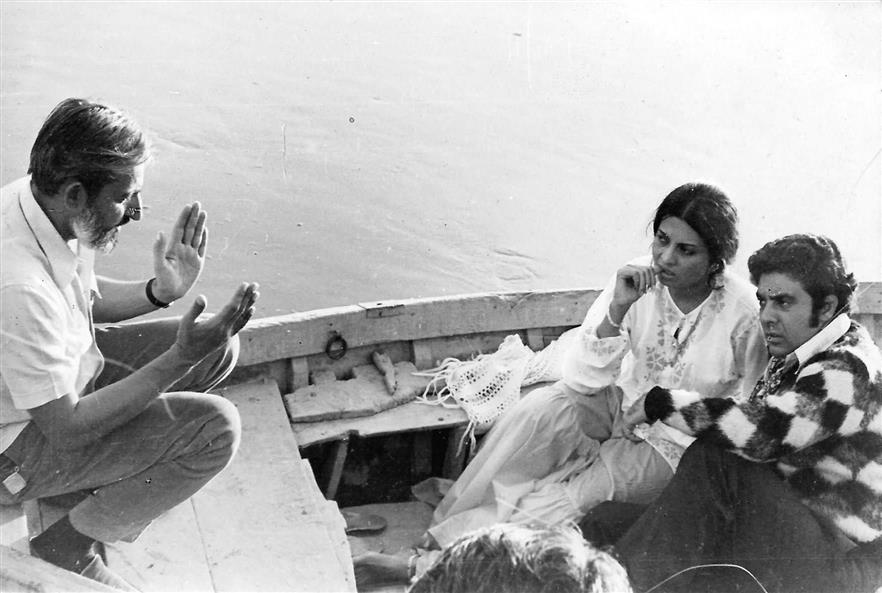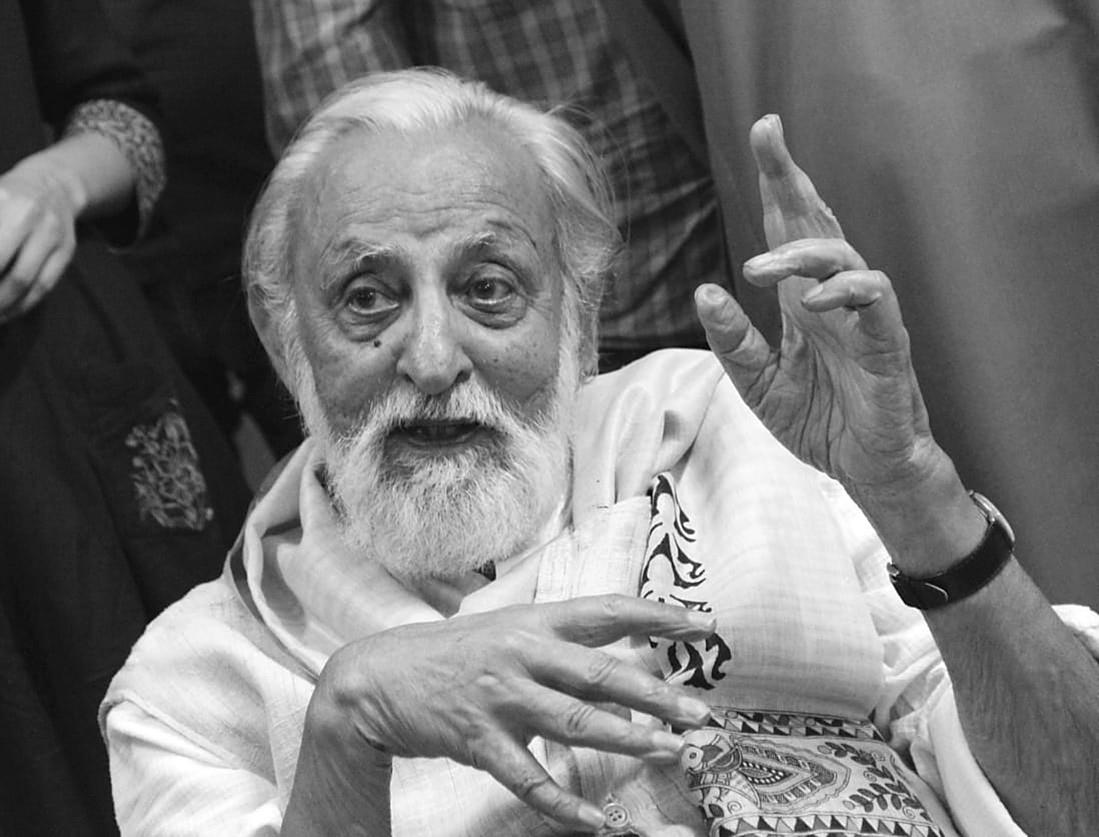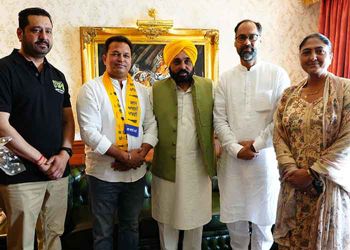
Balraj Sahni and Gita Siddharth in a still from the film. photos courtesy: MS Sathyu
Amitabha Bhattacharya
Shortly after my graduation, deeply immersed in the Film Society Movement, I watched ‘Garm Hava’ (‘Scorching Winds’) and remember vividly the impression it left on me. Satyajit Ray wrote a longish letter to a noted Bengali weekly in a spirited defence of the film. Those were turbulent days, especially in Bengal and large tracts of India. Fifty years later, when I saw the film recently, the experience was cathartic. I have changed, India has changed beyond measure, but the film’s appeal has not waned.

The director with Gita Siddharth and Jalal Agha.
Sathyu knows how to control and distil emotion; there is high drama but not a trace of melodrama
What makes ‘Garm Hava’ a classic, not by the standard of Hindi/Urdu films alone, but in the broader canvas of Indian cinema as well? The relevance of its content or directorial competence, powerful acting or its editing, scripting or musical score? Perhaps a combination of all these and more. Conflict, plight and despair in an Ashrafi Muslim family of Agra, following India’s Partition and Gandhiji’s assassination, posited in the larger context of growing social tension and mistrust between two communities, have been portrayed so sensitively that to describe it as one of the finest Partition films would also be inadequate.

In another influential essay titled ‘Four and a Quarter’ (1974), Ray commented on ‘Garm Hava’ with his characteristic candour, praising the theme, acting of the protagonists, and director MS Sathyu’s handling as calm, assured and entirely free from frills. “There are evidences that the film was made with small resources; but the occasional rough edge which results from it is more than compensated by the air of single-minded devotion which permeates the whole film.”
Developed on a story by Ismat Chughtai, modified by Kaifi Azmi based on his personal experience, the film captures the defining moments of a decent family falling apart, caught in the vortex of time. Salim Mirza, played by Balraj Sahni, is graceful under pressure with unwavering faith in Allah, and intends to stay back in Agra amidst mounting disturbances, while his brother Halim, a leader of the Muslim League, quietly moves to Pakistan with his son Kazim, who was in love with and was to marry Salim’s daughter, Amina (played by Gita Siddharth).
Their ancestral home, being in the name of Halim, was soon declared an ‘evacuee property’. Problems upon problems mount for Salim’s family — having to shift to a small house, to lose a business contract with the denial of a bank loan, having been charged as a Pakistani agent, and the like. Finally, the suicide of his daughter, whose marriage hopes had evaporated twice over, breaks his resolve. Totally dejected, Salim also decides to leave for Pakistan with his supporting wife (played by Shaukat Azmi) and their educated-unemployed son (Farooq Shaikh). While going to the railway station, they notice a protest march of progressive elements demanding justice and employment opportunities for all. Hope is ignited and they reverse their decision.
There are many reasons why the film stands apart. First, there is sadness but no rancour, and there are no villains. None is portrayed as all black. Whether acknowledged or not, there seems to be a distinct influence of Satyajit Ray on the film where the treatment is restrained, and the characters, mostly victims of circumstances, are real, vulnerable and humane. Mysore Shrinivas Sathyu knows how to control and distil emotion, and not let it run loose. There is high drama but not a trace of melodrama. This factor makes the film nuanced, adding to its artistic merit.
Second, this is a work suffused with human warmth. Even under the most trying circumstances, humour, love and fun do not desert the protagonists. In sequence after memorable sequence, the drama of life manifests itself in all its hues, investing the theme with credibility and richness. It goes to the credit of left-leaning Sathyu that the film, situated in such a grim context, has not been allowed to turn didactic or propagandistic. This is a reason for the film’s wide appreciation.
Third, Sathyu knows the potential of cinema as the highest form of commercial art, and has used this knowledge to the best advantage of the film. Outstanding performances by each actor, delectable music direction by Bahadur Khan, and exemplary screenplay by Kaifi Azmi and Shama Zaidi apart, this film radiates hope and effuses compassion.
Salim Mirza was wise enough to understand why their ancestral house was declared an ‘evacuee property’ or why he was charged as a Pakistani spy (to be acquitted later) — largely because of his inadvertence and complacence. He understood that bankers were refusing to advance a loan for his shoemaking business since many had left for Pakistan without clearing their bank debts, and that there were good and bad elements in both the communities. This firm faith in human nature he held dear. Therefore, while leaving for Pakistan, on the slightest sign of hope, he joins the procession with his son, and decides to stay back and fight as enlightened citizens for justice and common cause.
All these factors combined to make ‘Garm Hava’ a milestone in Indian cinema. The Censor Board sat over its clearance for many months, some groups issued threats against its release. Yet, the film was nominated for major competitions, and won the Best Feature Film on National Integration award. The film was restored and re-released for wider exhibition in 2014. And for a classic, people are still discovering newer meanings in the film.
Post-Independence India in 1948 was different from pre-Emergency India of 1974, and India today is very different from what it was half a century ago. But the film’s aesthetic charm and relevance have not dimmed, perhaps because the questions of communal harmony, tolerance, reconciliation and social inclusivity continue to be pertinent even today. ‘Garm Hava’ quietly prods us to examine ourselves.
Balraj Sahni, with arguably his best performance on screen, had passed away before the film was released. Sathyu (93) is fortunately still with us. Shouldn’t we celebrate the 50th year of ‘Garm Hava’ while nationally felicitating its maker?
Join Whatsapp Channel of The Tribune for latest updates.



























